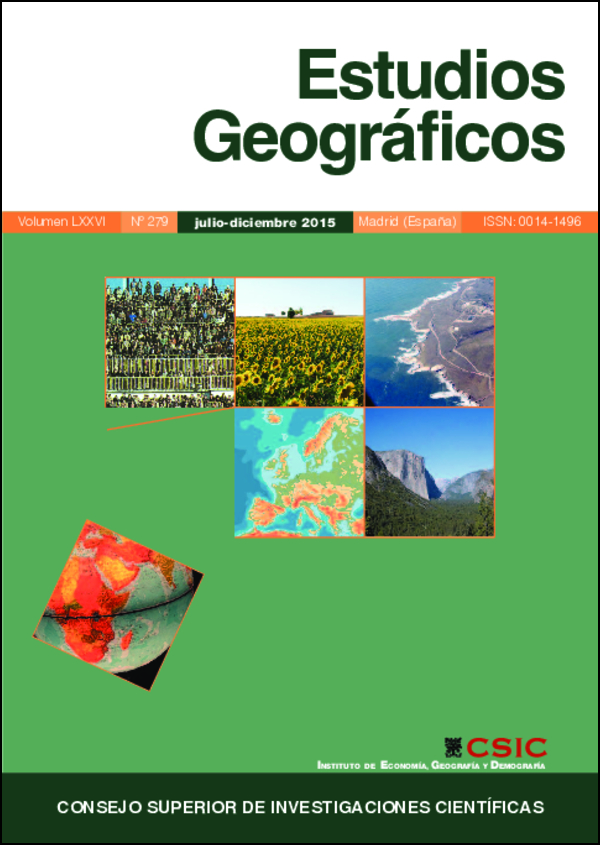Model for determining the load or carrying capacity of rivers and riverbanks for recreational use
DOI:
https://doi.org/10.3989/estgeogr.201523Keywords:
assessment of tourism and recreational use, riverbanks, carrying capacity, recreation tourism, linear weighted sumAbstract
The aim of this article is to determine the load or functional carrying capacity for the assimilation and recovery of rivers and riverbanks by compiling information on the environment, and to assess the potential for recreation from the environmental and scenic point of view. We set out to find the most significant basis for analysing the pressures limiting carrying capacity and constraining the demand for recreational use. This methodology will help planners and legislators in their decision-making. We also propose a methodology for assessing the recreational use of riverbanks, tested in a number of sites in the Madrid Region, in terms of the satisfaction the activity produces in the users, and the load or carrying capacity of the surrounding environment. A pilot site assessment is presented as a validation of the proposed methodology.
Downloads
References
Asah et al . (2012): "Involving Forest Communities in Identifying and Constructing Ecosystem Services: Millennium Assessment and Place Specificity". Journal of Forestry , 110/3, pp. 149-156 (8).
Butler, R. (2006): "The tourism area life cycle", Ontario: Channel View, 1, pp 1-33.
Feria Toribio, J. M. (2010): "Patrimonio territorial y desarrollo sostenible un estudio comparativo en Iberoamérica y Espa-a". Estudios Geográficos , 71/268, pp. 129-159. http://dx.doi.org/10.3989/estgeogr.0472
Garrigós Simón, F. J. et al . (2004): "Carrying capacity in the tourism industry: a case study of Hengistbury Head". Tourism Management , 25/2, pp. 275-283. http://dx.doi.org/10.1016/S0261-5177(03)00089-X
Hill, M. O. et al . (1975): "Indicator species analysis. A divisive polythetic method of classification and its application of Native Pinewoods in Scotland". Journal of Eco - logy, 63, pp. 597-613. http://dx.doi.org/10.2307/2258738
Homan, M. A. and Bennett, J. T. (1973): "Determinants of use of water based recreational facilities". Water Resources Bulletin, 5, pp.1208-1218. http://dx.doi.org/10.1029/WR009i005p01208
Hughes, G. (1995): "The cultural construction of sustainable tourism". Tourism Management, 16/1, pp.49-59. http://dx.doi.org/10.1016/0261-5177(94)00007-W
Kim, J. and Billard, L. (2011): "A polythetic clustering process and cluster validity indexes for histogram – valued objects". Computational statistics and data analysis , 55/7, pp.2250-2262. http://dx.doi.org/10.1016/j.csda.2011.01.011
Kline et al . (2009): "Toward a Rational Exuberance for Ecosystem Services Markets". Journal of Forestry, 107/ 4, pp. 204-212 (9).
MacBeth, J. (2005): "Towards an ethics platform for tourism". Annals of Tourism Research, 32, pp. 962-965. http://dx.doi.org/10.1016/j.annals.2004.11.005
Manning et al . (1999): "Carrying Capacity Research for Yosemite Valley: Phase II", in: "Study. University of Vermont / Studies Lab. Burligton, Burlington, Park". Unpublished report
Manning et al . (2001): "Visitor Experience and Resource Protection: A Framework for Managing the Carrying Capacity of National Parks". Journal of Park and Recreation Administration, 19/1, pp. 39-108.
Manning et al . (2007): Parks and Carring Capacity: Commons Without Tragedy . Washington DC., Editorial IslandPress, pp 37-42. PMid:18237665
McCool, S. and Lime, D. (2001): "Tourism carrying capacity: tempting fantast or useful reality". Journal of Sustainable Tourism , 9, pp. 372-388. http://dx.doi.org/10.1080/09669580108667409
Navarro, E. et al . (2012): "Carrying capacity assessment for tourist destinations. Methodology for the creation of synthetic indicators applied in a coastal area". Journal of Environmental Management , Touris Management, 33, pp. 1337-1346. http://dx.doi.org/10.1016/j.tourman.2011.12.017
OMT Organización Mundial del Turismo (WTO, World Tourist Organization) (2005): Tourism??s Potential as a Sustainable Development Strategy . Madrid, Spain, World Tourist Organization.
Prato T. (2001): "Modeling carrying capacity for national parks". Ecology.Economist, 39, pp. 321-331. http://dx.doi.org/10.1016/S0921-8009(01)00248-8
Ritchie, J. R. B. and Crouch, G. I. (2004): The competitive destination. A sustainable tourism perspective . Oxon, UK, CABI Publishing.
Saarinen, J. (2006): "Traditions of sustainability in tourism studies". Annals of Tourism Research , 33/4, pp. 1121-1140. http://dx.doi.org/10.1016/j.annals.2006.06.007
Salerno, F. et al . (2013): "Multiple Carrying Capacities from a management-oriented perspective to operationalize sustainable tourism in protected areas". Journal of Environmental Management, Elsevier , 128, pp. 16-25. http://dx.doi.org/10.1016/j.jenvman.2013.04.043
Saveriades, A. (2000): "Establishing the social tourism carrying capacity for the tourists resorts of the east coast of the Republic of Cyprus". Tour. Manage , 21, pp. 147-156. http://dx.doi.org/10.1016/S0261-5177(99)00044-8
Selin, Steve et al . (2009): "Outdoor Recreation Research and Education for the 21st Century: Defining National Direction and Building Capacity". Journal of Forestry, 107/7, pp. 346-349 (4).
Taboada, J. A. and Cotos J. M. (2005): Sistemas de información medioambiental . La Coru-a, Netbiblo.
Urbiston, L. (1973): "El aprovechamiento recreativo de los embalses espa-oles". Revista de Obras Públicas, Julio, pp.18-23.
Valenzuela Rubio, M. (1989): "Los espacios para el ocio asociados al agua, o como Madrid a-ora el mar", en VV AA: Los paisajes del agua... Valencia, Univ. de Valencia/Univ. de Alicante, pp. 371-383. www.cbd.int, 2014. (Verified: 03/09/2015).
www.depi.vic.gov.au/forestry-and-land-use/forest-management/forest-managementplans, 2014. (Verified: 03/09/2015).
www.ecoturism.org, 2014.TIES, 2006. (Verified: 03/09/2015).
www.madrid.org/cs Comunidad de Madrid. 2013. Consejería de Medioambiente. PIAM, Plan Forestal 2000 – 2019. Available on line. (Verified: 03/09/2015).
http://www.tennessee.gov/environment/, 2014. (Verified: 03/09/2015).
Zárate Martín, M. A. (2012): "Paisaje, forma y turismo en ciudades históricas". Estudios Geográficos, LXXIII/273, pp. 657-694. http://dx.doi.org/10.3989/estgeogr.201223
Downloads
Published
How to Cite
Issue
Section
License
Copyright (c) 2015 Consejo Superior de Investigaciones Científicas (CSIC)

This work is licensed under a Creative Commons Attribution 4.0 International License.
© CSIC. Manuscripts published in both the print and online versions of this journal are the property of the Consejo Superior de Investigaciones Científicas, and quoting this source is a requirement for any partial or full reproduction.
All contents of this electronic edition, except where otherwise noted, are distributed under a Creative Commons Attribution 4.0 International (CC BY 4.0) licence. You may read the basic information and the legal text of the licence. The indication of the CC BY 4.0 licence must be expressly stated in this way when necessary.
Self-archiving in repositories, personal webpages or similar, of any version other than the final version of the work produced by the publisher, is not allowed.















